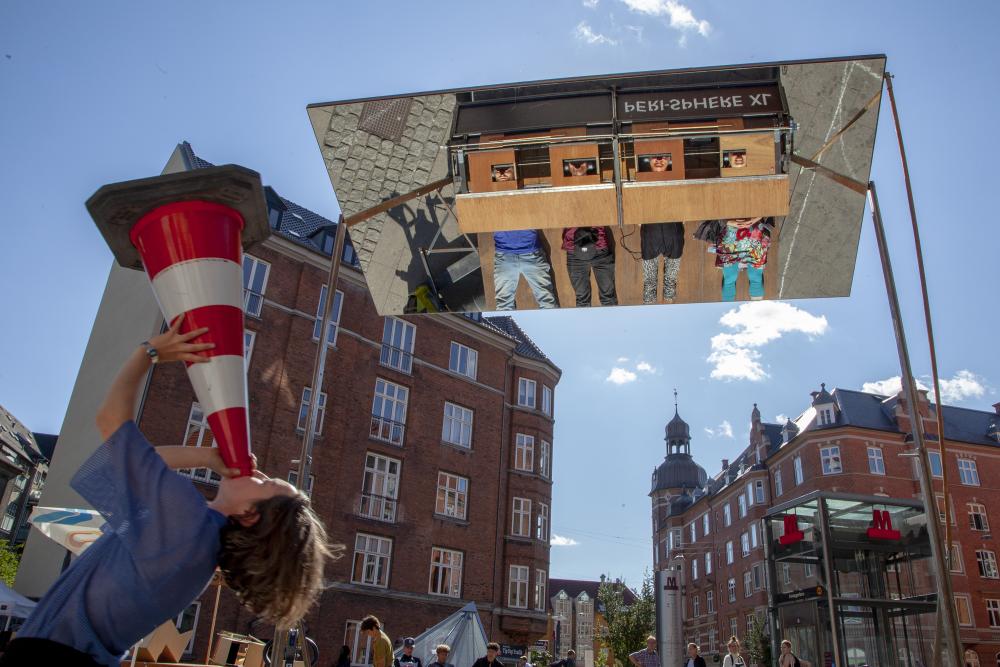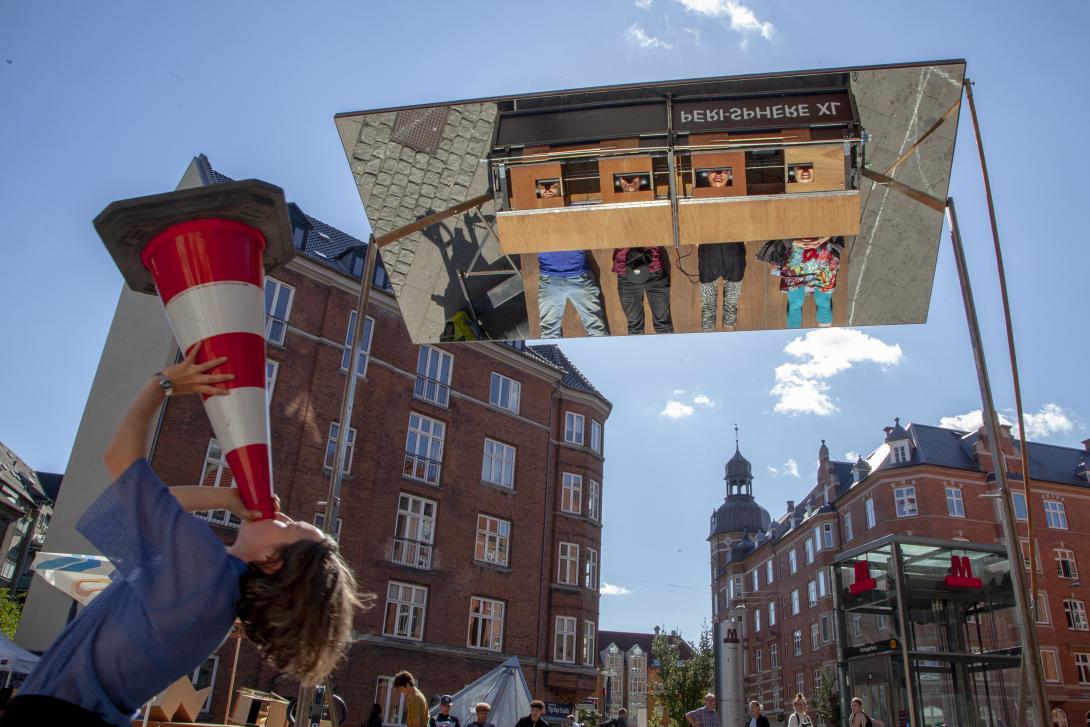I WANT TO TRANSFORM PUBLIC SPACE TEMPORARILY INTO A PLACE OF INTROSPECTION
A conversation with Benjamin Vandewalle
Three years ago, when he began his residency at Kaaitheater, we sat down with Benjamin Vandewalle. At the time, he was toying with the idea of organizing an artists’ fair and wanted to become a self-declared city choreographer. In 2019, that artists’ fair has taken shape under the title Studio Cité.
You have been toying with the idea of Studio Cité for a number of years. Now it has become concrete. What can we expect?
Studio Cité is a kind of unusual mini festival. It is both recognizable due to its fairground appeal, but also very strange. Its fairground character lies in the collection of small formats, consisting of boxes and installations that are very sensorial. I approach the audience as a fair would and whisk them away in something that shakes them to their core. Generally, the whole thing is very accessible and very folky, but not like in an average fair where everything is geared towards adrenaline and entertainment in the first degree. The installations are not average attractions. They generate experiences that catapult back into the body of the viewer, aiming straight at their own self-image. It is a kind of magnifying glass or mirror – many of the installations actually use mirrors. As though all the installations are reflections of the way in which we look at ourselves, public space, and one another.
When we think of a fair, we think of people who meet up and enjoy themselves. But is Studio Cité more about the introspection of each visitor?
Yes, absolutely. The installations look very innocent, but they leave you quite shaken. Inter-view is a good example: it looks very innocent. People think that they are going to watch a video, but when they enter the installation, they are confronted with their own insecurities about what they look like and how other people perceive them. They sometimes come out completely silent or even in tears, while a queue of new visitors with high expectations is forming at the entrance.
Perception is central to Studio Cité. The audience must sometimes completely succumb to your choreography of gaze, but you occasionally also allow the audience actively to discover different ways of looking.
That’s right. The installations are very corporeal in the sense that I emphasize people in their bodies very strongly. You might see that as the leitmotif throughout the entire cité. It is also aligned with my exploration of choreography as such and how to transmit it to the audience. All the installations follow the logic of an internal choreography: the body of the audience is employed in such a way that the movements run straight through the viewers’ bodies. In this sense, Studio Cité is about raising your consciousness of your own body in the city.
What do you mean precisely by ‘a choreography that runs straight through the body of the viewer’?
There is no mediating performer who performs the choreography for the viewer. As a dancer/choreographer, of course I am interested in watching dance, but I have learned much more from the experience of dancing than I have from watching it. All the installations were created based on the desire to transmit the sensations and experiences that you feel as a dancer to the bodies of the viewers in the most immediate way possible, without that experience first having to go through the body of a performer. Although there are dancing bodies in Studio Cité, they are always in relation to an audience that moves too.
How important is the relationship with the city or with the location of Studio Cité? Why is it not just located in a theatre?
I want to transform public space temporarily into a place of introspection. To me, the relationship with the city is about how we experience our environment in a direct and physical way. Each installation adds a new twist to the way we understand the space around us. In a certain sense, my aim is to transform the everyday choreography of the city into something else. The city is determined by common, unspoken but prevalent rules and behavioural codes, and Studio Cité challenges them. I think that it has always been my wish – and that is why I always look for public spaces – to show that public space is a kind of shared reality. You might think of it as a giant play, a great construction that we unconsciously accept as the norm. And it is precisely that norm that I want to puncture; my installations are an attempt to tear it open.
In these everyday surroundings, I also try to find a new aesthetic. In that sense, I do not want to create too many new physical things. Instead, I want people to see their familiar surroundings in new ways. By guiding their gaze with my installations, I enable them to experience the city in a new way.
One of the other aspects of public space is that you encounter other people who use and interpret that space in a different way. How do you deal with that?
That’s right. During set-up in Copenhagen, we placed a large container on a square. There was a kebab salesman who always parked his car there and he was very angry that he had to move his car a few metres further away. But it all turned out well in the end, and he even gave us some free falafel.
But there are of course also the random passers-by. I think it is these people who make the work really interesting because there is such a broad variety of visitors: both culture lovers who come intentionally but also random passers-by who might be culture haters or culture virgins. The cité is organized as a meeting place with a bar, beach chairs and parasols. The interesting thing about working in public space is that it generates conversations between people from all layers of society about the experiences that everyone has in the installations. There is something about the intensity of these experiences that makes people feel a need to talk about them. The cité intentionally creates openings to talk to one another. Some of the installations are experienced in groups. Or they literally place you opposite someone else. It is a constant search, but I do see it as my role to facilitate these conversations.
You not only work in public space. For example, in 2017, you made Common Ground in cooperation with Kobe Wyffels and Hannah Bekmans, two dancers from Platform-K [a company for dancers with disabilities]. Are work in public space and stage performances two distinct parts of your artistic practice?
In a certain sense, they run parallel. Common Ground is likewise based on the exploration of the norm and how you can deviate from the norm. This research is very much supported by my interaction with Kobe and Hanne, who constantly try to shake up the norms. At the same time, Common Ground is a kind of personal capitulation to return to the theatre with its common rules of construction of audience manipulation. The theatre is a very different playground than public space, but my work in both always looks for that one leitmotif about who we are and how we can go in search of new realities together. To me it is important to highlight the malleability of our own reality.
Finally, what about your ambitions of becoming the city choreographer?
My original desire to be city choreographer – as I had pictured it two years ago – has not worked out yet. My aim then was to have a long-term presence in public space, but Studio Cité will only be on the square for three days. The question of how, as a choreographer, you can appropriate public space as a performance space does continue to fascinate me. My aim now is to approach the idea of being the city choreographer in a different way. For my next project, I want to invest in the long-term presence as a dancer in the space.
I would like to be present as a dancer in the city every day for several months. No installations, just my body. In other words, completely the opposite of Studio Cité, in which I have become a kind of technician. As the city choreographer, I would like my long-term presence to leave a mark. Like a drop of water that always falls in the same place on a piece of stone, gradually transforming the stone. Or like the little squirrel in the film Ice Age: a figure who becomes part of the everyday surroundings and whose actions always leave a mark.
A conversation with Benjamin Vandewalle, by Lana Willems & Eva Decaesstecker (Kaaitheater).

